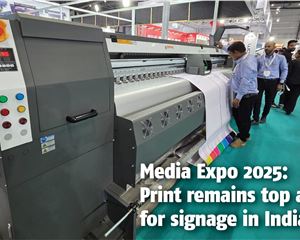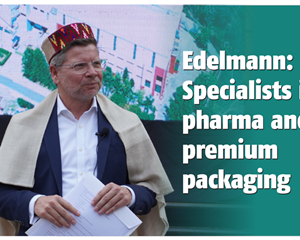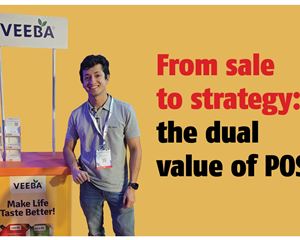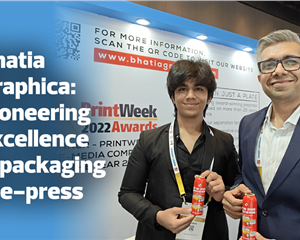Number three and eyeing the top spot
Pradeep Unny, AVP for production, Amar Ujala Group, talks to Rahul Kumar about how the news paper major has entered commercial printing by establishing a separate plant nearby in Noida.
13 Jan 2014 | By Rahul Kumar
Rahul Kumar (RK): What are the new developments in the Indian newspapers industry on the technical front? Does size (broadsheet, Berliner or midi and tabloid) of the newspaper really matter in printing process?
Pradeep Unny (PU): Yes, the size of a newspaper does matter. We are producing both broadsheet and tabloid but do not see any chance for making a switch to the Berliner size. Regional markets will take time to adopt to a tabloid newspaper. Since we have witnessed growth in this segment, we are sure that growth is certainly there. We are planning to launch a new tabloid very soon.
RK: Do Indian press manufacturers meet your demands?
PU: Yes, the Indian manufacturers meet our demands of good and consistent printing presses. However, the consistency of European-made machines is far better when compared to the Indian presses. You can dismantle and rearrange the foreign- made ones but for the Indian-made, you are dependent on some jugaad. Nevertheless, the Indian printing press manufacturers are opting for CNC machines and other modern manufacturing equipment. We can expect that Indian machines, too, shall be offered with the same functions and facilities in the future.
RK: What is your role at Amar Ujala?
PU: I am responsible for flawless production in all the printing centres and delivery of the newspapers on time, hiring and training the entire technical newspaper production team. I adopt and implement technological advancement according to our requirement.
RK: What kind of initiatives have you undertaken to ensure the technical development of Amar Ujala?
PU: Being from a printing background, I know how it hurts when the quality of newspaper production gets hampered. If your advertisement and news content is not printed well, a reader will not buy or read your daily again. Being a semi-technical company, my core strength and my focus is our workforce and for the last three years I have put them as my top priority. We provide shopfloor training for our staff on a regular basis as they should be in tandem with the goals we intend to achieve. Training is one of the most effective tools, we have at our disposal.
We organise two programmes – one for our photographers and the other for government officials/agencies to create awareness about the prepress and printing defects. Our current focus is more on the pre-press side and therefore, we are planning to organise few programmes at our printing facilities in remote areas.
We have been successful in resolving 90% quality related issues with advertisement printing because of these continuous training programmes. We send regular updates to the creative media agencies in order to make them aware of the changes.
RK: One of the German manufacturers once told us that India is a primary market for the 4x1 printing presses. What is your take on this? And will printers shift from 2x1 to 4x1 format printing press?
PU: I want to adopt the 4x1 format but I cannot because of the huge investment involved. For a 4x1 printing presses, you need a solid support of advertising, marketing and circulation. Most of the newspaper publication houses want all pages colour because their competitors are doing it. To talk idealisticaly, all newspaper publishers should join hands and create a common technical platform. Ultimately, all the newspaper houses are cutting their input costs. Increment in the cover price of newspapers will be also helpful because you can put the money generated off it to adopt new technologies. When all the TV channels and radio networks match their advertisement slots, why can’t newspapers?
RK: For flawless production and satisfaction of the newspaper industry, what are the precautions to be taken by an ink, paper and printing press manufacturer?
PU: Standardise the production. The ink should be standardised. For flawless production you also need software for news content. These software stop the repetition of stories and can also do auto spell check.
We have developed customised quality management system, software for pre-press, true feedback system and it works regularly. Every newspaper production house consumes multiple newsprints. Hence we have in-house quality checking lab for the same. All the manufacturers like TechNova, Kodak, DIC and others have set standards of production.
RK: What is the future of inkjet printed plates for offset in newspaper segment?
PU: Yes, there is a future for inkjet printed plates but for small production newspapers, who cannot afford CTP.
RK: As the press speeds go up, what parameters should the ink, paper and press makers consider for making top-grade equipment and consumables for newspaper printing?
PU: Please follow the international standards. Inks and chemicals manufacturers follow the standards and Indian newsprint manufacturers need to adopt standards too. We are a 100% recycled newsprint user with 90% of it being procured from Indian manufacturers and 10% is imported.
RK: How do you see UV printing applications in the Indian newspaper industry?
PU: As I said, semi-commercial printing plants are not viable for newsprint production houses. So there is no space for UV printing until or unless your advertisers are ready to pay the premium ink cost or the cost come down drastically.
RK: What is the trend considering the heatset machines are being replaced by coldset machines fitted with LED lamps, hybrid inks, etc. Everywhere space is a constraint. Do you see a trend where a single machine does the work of two machines with same quality – the concept of combination press?
PU: The production quality will be always different. A coldset machine cannot produce the quality like heatset printing presses. Whatever arrangements you do, the ink drying systems are entirely different. Drying inks with a drier cannot match the quality of auto drying. The production cost on a heatset printing press is also very high, so people are seeking other options. I do not know how the hybrid ink will help the newspaper publication houses, whether in drying or anywhere else.
RK: What sort of modifications do you see on the shopfloor? For example, inking system, dampening system, reel stand, folder, drive system, digital plates, toolings, inspection systems, etc which is modifying the way in which business is being managed?
PU: We use conventional dampening system but spray dampening system is the future. You will save on power and would not damage the environment too. Auto inking system is a good option for huge volumes. However, auto splicer and reel changer, which save your time, are going to trend in the near future. Short length printing presses will be also useful because of the cost of real estate is too high and these printing presses give you better registration with lesser wastage. 70% cost of our newspaper is newsprint, so cost-cutting measures can be implemented there, too. On the shaftless machines you can save almost 30% on the operating cost of the power consumed compared to a shafted machine.
RK: There is much more attention paid to environment now; and re-cycling of paper is in focus. Do you anticipate any kind of printing problem with recycled newsprint?
PU: Being a 100% recycled newsprint consumer, we face few problems but those are taken care of from time to time. It depends on proportion of virgin pulp added to strengthen it. Being a regional newspaper your budgets do not allow you to use all imported newsprint made of virgin pulp.
Thermal plates are less expensive as compared to violet. Violet is also providing the same speed as thermal. It is a stable technology and our team is comfortable with it.
RK: There is a lot of discussions on cut-off sizes, now 546 is in use, what is the ideal cut-off for web offset printing presses?
PU: 546 is in use but 533 is the better option. Cut-off size is the easiest point to cut corners. Ultimately, newspaper production houses would need to go for smaller size and there is no other option. Indian newspapers will shift to a size between broadsheet and Berliner. Most of the Indian manufacturers are making this cut-off. Bhaskar has installed printing presses with the 533mm cut-off size.
RK: You have entered commercial and books printing, what kind of opportunity do you see?
PU: We have done a business of almost Rs 10-crore in last year with similar setup. And now we have established a separate facility for the same. We aim to do more. We are very optimistic of our commercial setup. Our management invested money in technological advancements. We have also taken contractual printing of smaller newspapers which cannot afford setting up printing press at several locations. We are printing newspapers, flyers, and educational books. For this, we have ordered several finishing equipment. By the year end we will be in full flow of production.
RK: What is the key to Amar Ujala’s recent growth and expansion plans?
PU: Single point focus on growth. We meet twice a month and a lot of interaction and communication programme with management takes place on a continuous basis. Since the last year, we have increased the production of Amar Ujala by 1.5 lakh copies and so has the advertisement revenue increased.
RK: What is the role of the technical team to sustain the price war which has broken out in the print media?
PU: We are in the process of cutting our corners. Our overall newsprint wastage in 2012-13 was only 4.42% of our total production and this year we are looking at reducing it to 4%, given the semi-automated process at Amar Ujala. Also, we have saved huge sum on inks without any ink saving software. We have also made huge savings on account of strict monitoring and maintaining the gsm of the newsprint.
RK: Will mergers and acquisitions make any impact on the printing facilities of the companies?
PU: I do not think so. If the purpose is to kill a particular brand then it will make an impact. Other things apart, the mergers and acquisitions within the industry will help the industry to sustain.
RK: Waterless offset, will it be a viable process in India?
PU: Presently we have to maintain the balance of water and ink. In waterless offset, we will have to maintain only the ink density. It will be better anyway as one of the biggest variable is out of the process and in future we will opt for it. I am yet to study the technology in depth.
RK: What is the suitable press speed for the Indian market?
PU: For a small newspaper, an ideal speed is 35,000 copies an hour but, for a big production house, it depends on the number of copies. The biggest drawback of offset is the number of variables like temperature, substrate, ink, water, and manpower, that one has to control.
RK: What are your future plans? Any important project you are embarking on?
PU: We are working towards implementing an integrated tower, auto reel stand and shaftless printing presses for our new plants and a couple of new projects are in the pipeline.
| Factfile |
|
Publications: 118 editions of Amar Ujala, Hindi tabloid Compact, magazines like Safalta Locations: 18 print locations spanning across six states – Punjab, Himachal Pradesh, Haryana, Jammu & Kashmir, Uttar Pradesh and Uttarakhand and one union territory, covering 167 districts. Print power: 34 printing lines from Indian manufacturers Pressline and TPH including 140 4Hi towers with cut-off size of 546mm; prints 22.2 million copies per day of Amar Ujala and six-lakh of Compact; consumes more than two lakh thermal CTP plates per month of 586mm size; consumes 150 tonnes of printing ink per month. Amar Ujala is at number three in the regional language newspaper publication. It has recently entered into commercial printing arena by establishing a separate plant nearby in Noida. |













 See All
See All